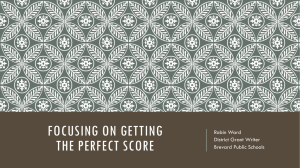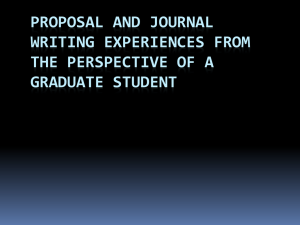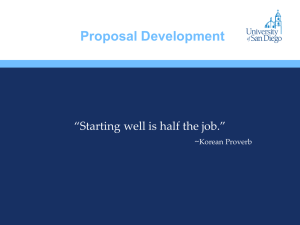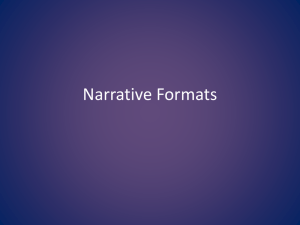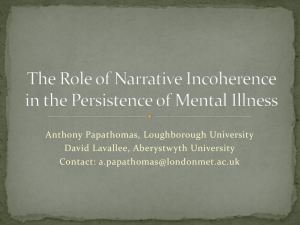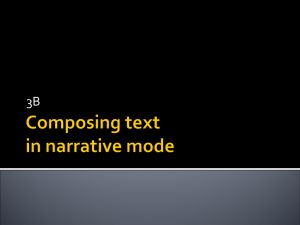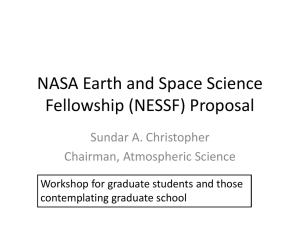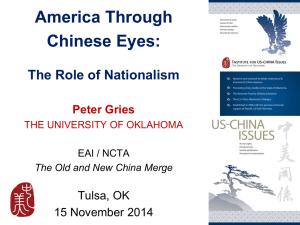Project Narrative
advertisement
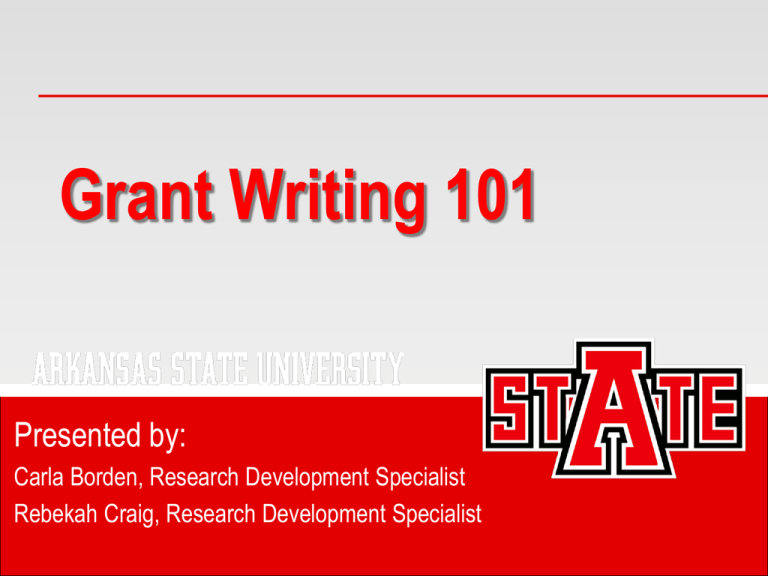
Grant Writing 101 Presented by: Carla Borden, Research Development Specialist Rebekah Craig, Research Development Specialist Today’s Objectives Basic Components Standard Proposal Content Summary or Abstract Program Narrative or Project Description Goals/Objectives; Hypothesis & Aims; Research Questions Need; Background & Significance; Rationale; Theoretical Framework Program Plans; Methods; Strategies; Research Plan Management Plan; Personnel Evaluation; Assessment Budget & Budget Justification Attachments CV Letters of support/commitment Other supporting documentation Project Summary – 1 page Address merit review criteria (Intellectual merit & broader impacts) Project Description – 15 pages Introduction Background and Significance Results from prior NSF Support Research Plan/Timeline References Biographical Sketch – 2 pages Budget Budget Justification – 3 pages Current & Pending Support Facilities, Equipment & Other Resources Data Management Plan Proposal Title – 80 characters, including title Project Summary – 30 lines of text Project Narrative Specific Aims – 1 page Research Strategy - Generally 6 – 12 pages Significance, Innovation, Approach, Timeline Bibliography/References Cited Other Attachments: Vertebrate Animals, Consortium Agreements, Letters of Support, Resource Sharing Plan Biographical Sketch – 4 pages Budget – R&R Budget Component OR PHS 398 Modular Budget Component Budget Justification Other Project Information – Facilities & Other Resources, Equipment, Public Health Relevance Statement Organizational Background Statement Project Narrative – 10 pages Research Questions Research Design Data Sources Data Analyses Personnel Capability Organizational Capacity Outline for Research Report Outcomes and Measurements Schedule Plans for Dissemination Biographical Sketches Project Budget Form Statement of Significance and Impact List of Participants Project Title – 125 characters Project Narrative – 25 double-spaced pages “Write with evaluation criteria in mind” Project Budget Brief Resume (and other Appendices) Statement of History of Grants What’s the Difference? Academic Writing Grant Writing Scholarly Pursuit: Individual Passion Sponsor Goals: Service Attitude Theme-Centered: Theory and Thesis Project-Centered: Objectives and Activities Impersonal Tone: Objective, Dispassionate Personal Tone: Conveys Excitement Few Length Constraints: Verbosity Rewarded Strict Length Constraints: Brevity Rewarded ACADEMIC GRANT Scholarly Pursuit • Individual passion • Advance your career Sponsor Goals • Service attitude • Adapt expertise Know the sponsor Mirror key phrases and terminology ACADEMIC GRANT Past Oriented • Work that has been done Future Oriented • Work that should be done Find a healthy balance • • Contextualize proposed work in literature • Extend boundaries • Okay to imagine ACADEMIC GRANT Expository Rhetoric • Explaining • Logical progression Persuasive Rhetoric • Selling • Strong pitch • LEAD with your exciting ideas • Use strong, active language • Write with funders & reviewers in mind • Why are you uniquely deserving? ACADEMIC GRANT Theme-Centered • Theory & thesis • Realm of ideas • Examine issue • Final conclusions Project-Centered • Objectives & activities • World of action • Accomplish goals • Expected outcomes • Avoid proposing a “study” or “examination” unless specific to RFP • Ever-present Questions: • How will I do this? • How will I measure the outcomes? • Encourage excitement for your project • Seek their endorsement • Use first-person voice • May seem like violation of editorial rules • Seek counsel on concept before writing • Contact program officer • Collaborate across colleges & institutions • Share the writing responsibility • ALWAYS have someone proofread • Follow ALL formatting directions • Grammar & sentence structure matter • Flag sentences more than 3 lines long • Be precise with word choice • Describe your project to your mother • Seek proofreaders outside your discipline • Read one sentence at a time from back to front Institute for Research Development “A grant is an infomercial, not a term paper. Get up and Stretch!!! Thinking Like a Reviewer NIH Peer Review Revealed: (3:25 – 9:10) http://www.youtube.com/watch?v=fBDxI6l4dOA NIH Tips for Applicants: http://www.youtube.com/watch?v=9cNRMsCGfHo NIH Review Criteria Significance Innovation Approach Investigator(s) Environment NSF Review Criteria Intellectual Merit (potential to advance knowledge) Broader Impacts (potential to benefit society and contribute to the achievement of specific, desired societal outcomes) For both above, evaluate: Creative, original, or potentially transformative concepts Well-reasoned, well-organized plan based on a sound rationale with a mechanism to assess success Qualifications of individual, team, and institution Adequate resources available to the PI (institution or collaborations) NEH Review Criteria Intellectual significance of the project Pertinence of research questions and appropriateness of design Qualifications, expertise, and commitment of PD & collaborators Soundness of dissemination and access plans Potential for success, including completion within time frame NEA Review Criteria Artistic Excellence Novelty of the research questions, datasets, and/or methodological approach. Overall rigor of the research plan (Clarity & appropriateness of design; Analytical techniques; Quality/validity/reliability of data; Qualifications of project personnel) Artistic Merit (NEA Understanding = the value and/or impact of the arts is expanded and promoted) Potential of the project to achieve NEA Understanding; includes increasing diversity of fields of expertise that contribute to arts-related research, & heightening relevance of arts-related research to policy and practice. Appropriateness of the proposed performance measurements and their ability to demonstrate NEA Understanding; includes statement of how the applicant will determine whether the project's goals have been achieved, and how those goals will achieve NEA Understanding. Dissemination Plan Feasibility of success with requested budget and resources What are YOUR review criteria? “Objection Obliterator” Do you have the right experience as PI/PD? Is the hypothesis or question being proposed properly supported? Do the Specific Aims / Project Summary answer the core hypothesis or question being asked? Is the money being asked for going to make substantial forward progress in the field? Is the community interested in the work you are proposing? Morgan Giddings at https://marketyourscience.com/ Persistence pays… “. . . because there is considerable turnover annually of individual reviewers and of review panels, it can pay to be persistent; funding chances usually improve with resubmissions.” Miner JT. Res Mgmt Rev. 2011; 18(2):85-108. …but trial and error doesn’t! Actions Results Beliefs Always address reviewer comments Rejection = lack of confidence = procrastinating or writing without confidence = rejection = reinforcement of downward spiral Acquiring grant-writing skills + persistence + practice = success Becoming a Reviewer NSF: https://www.nsf.gov/bfa/dias/policy/merit_review/reviewer.jsp Dept of Education: http://ies.ed.gov/director/sro/peer_review/application_review.asp and http://www2.ed.gov/about/offices/list/ope/trio/seekingfieldreaders.html NIH (early career reviewer): http://public.csr.nih.gov/ReviewerResources/BecomeAReviewer/Pages/ Overview-of-ECR-program.aspx NIJ: http://www.nij.gov/nij/funding/reviews/peer-reviewers.htm NEH: https://securegrants.neh.gov/prism/ ORAU Developing the Narrative Follow the instructions (even the very picky details) Write for review MUST flow from well-crafted, peer-reviewed specific aims Taking Aim Irrational Reviewers Who cares? Your reviewer’s enthusiasm is an emotional reaction, not a rational one. There is no fixed notion of value; it is arbitrary. Reviewers will not automatically discern the value of your proposed work. You must communicate the value to them – they may not “guess” correctly on their own. Credit: Morgan Giddings. The Back Door to Funding Report Feelings Count! Your proposal must feel: Exciting Interesting Innovative Important Reviewer friendly Lead with emotions and justify with logic Credit: Morgan Giddings. The Back Door to Funding Report Aiming for Value “I develop computer networks.” So what? “I develop computer networks to allow researchers to transfer data back and forth rapidly.” Narrow appeal. “I develop computer networks to allow new kinds of interaction and collaboration that will revolutionize how people share data and work together remotely.” Better… but too vague. Aiming for Value “Physicists are in an important race to find extraterrestrial life, but their work is significantly impeded because the massive data sets they collect must be transferred physically on remote desert roads by Jeep. Our new networking technology will connect the remote site with the data processing center to allow data transfer and collaboration in real-time, dramatically accelerating the project.” Now you’re fundable (but know your audience; may need to broaden statement). Credit: Morgan Giddings. The Back Door to Funding Report You probably learned everything you need to know before high school! Begin with an outline (use solicitation) Subject and verb One main idea per paragraph Avoid lengthy sentences Use commas & semi-colons Spelling & grammar matter Narrative Text Progression For each paragraph and sentence ask: How does this link to what I’ve just finished? Whose story is this sentence? What’s going on here How will this thought develop? What more do I have to know? What is the most important piece of information here? Utilize figures, tables & flow charts to save text Provide engaging legends that can stand on their own (convey a point) Consider white space Passive vs. Active Voice Mistakes were made. vs. I made a mistake. The student’s response was measured. vs. We measured the student’s response. The electric identifier was used to solve the problem. I used the electric identifier to solve the problem. The problem was solved with the electric identifier. Wordiness Get past the subject and to its verb quickly! Some scientists, because they write in a style that is impersonal and objective, do not communicate easily with laypeople. Some scientists do not communicate easily with laypeople because they write in a style that is impersonal and objective. Questions? Homework Refine specific aims Begin drafting narrative Communicate with your ORTT Specialist
